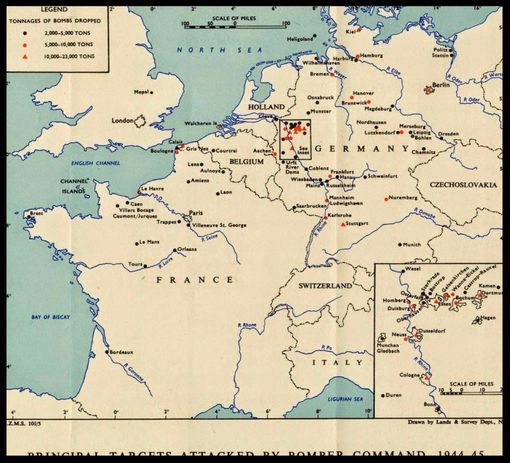The Raid on Stuttgart - 15/16th March 1944

On the evening of the 15th March 1944, having flown just eight missions ND474 was being prepared by her ground crew and together with 17 other aircraft, she was scheduled to leave RAF Fiskerton that evening on a raid to Stuttgart.
In the afternoon of the same day, the seven names of the new crew were listed on the operations board and they were then required to attend a pre-mission briefing. This was to be their first mission together, they knew they had to complete 30 missions before being released from operations and that as a new crew; their first five missions would be the most dangerous.
Despite the terrible odds stacked against them, the young crew of ND 474 prepared to leave for Stuttgart. They had a meal together and collected their flying suits from the locker rooms.
As the light faded ND474 rumbled down the runway laden with its load of high explosive and incendiary bombs together seventeen other Lancaster's from 49 Squadron, Fiskerton.
ND 474 took off from RAF Fiskerton at 19:05 and was the third aircraft to leave the airfield. The main raid to Stuttgart consisted of 863 aircraft - 617 Lancasters, 230 Halifaxes, 16 Mosquitos - all from different squadrons based in and around Lincolnshire.
At 20:05, five minutes after the formation of bombers flew across the coast of France, the German fighter controller had been altered and had split his forces into two parts. The bomber force flew over France nearly as far as the Swiss frontier before turning north-east to approach Stuttgart.
This delayed the German fighters contacting the bomber stream but, when the German fighters did arrive, just before the target was reached, the usual fierce combats ensued.
37 aircraft - 27 Lancasters, 10 Halifaxes - were lost, 4.3 per cent of the force. 2 of the Lancasters force-landed in Switzerland. Adverse winds delayed the opening of the attack and the same winds may have been the cause of the Pathfinder marking falling back well short of the target, despite the clear weather conditions. Some of the early bombing fell in the centre of Stuttgart but most of it fell in open country south-west of the city. The Akademie was damaged in the centre of Stuttgart and some housing was destroyed in the south-western suburbs.


"No enemy plane will fly over the Reich Territory"
Hermann Goring
British Royal Air Force mock German High Command.
At 23.15Hrs over Bolstern, south west of Salgau, at a height of 6,200 metres, ND474 was intercepted by a German night fighter.
Having completed their mission and releasing that their aircraft wouldn't make the journey home to Fiskerton, the crew of ND 474 turned south towards neutral Switzerland, this being a pre-planned escape strategy in the event the aircraft was unable to make it home.
Just eighteen minutes flying time from the Swiss border, ND 474 crashed into a field near the village of Bolstern and all the crew were sadly killed.
The people of Bolstern ensured that the crew had a Christian burial in their village church, they prayed for the crew and tended the seven graves of the 'English Flyers' from March 1944 until 17th July 1948, when a special unit moved the crew to Durnbach War Cemetery, Bad Tolz, Bayern.

